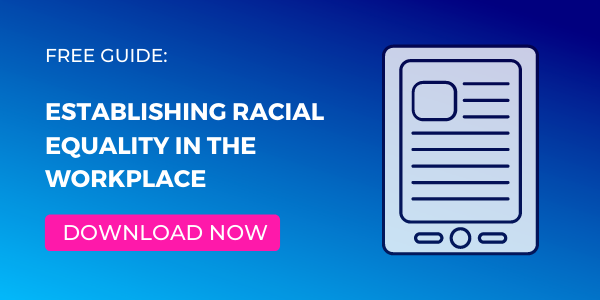Creating an anti-racist workplace does not happen overnight; it’s the result of consistent, deliberate effort and total company buy-in. No one knows that better than the team at Fractured Atlas, who has been working for years to implement an effective, lasting strategy.
Built In spoke with Lauren Ruffin, Co-CEO & Chief External Relations Officer, and Tim Cynova, Co-CEO & Chief Operation Officer, for their insight on what the journey to establish an anti-racist workplace looks like, and what’s worked for the Fractured Atlas team.
Read on to learn five key takeaways from the conversation, and download the complete guide to access all of the insights.
An in-depth analysis of diversity, equity, and inclusion in the technology industry.
#1: Make it a personal and professional journey.
Many companies make it a priority to diversify their workforce and create a more inclusive work environment each year, and most continuously miss the mark. What changed the game for Fractured Atlas was having their experience be both staff-driven and personal.
If anti-racism isn’t at the core of your mission, it won’t take root in your organization. All employees must commit to continuous education and self-reflection. For White leaders, this is especially important and requires learning about privilege, white fragility and how racial inequities occur within your organization.
#2: Question everything.
Part of building an anti-racist work environment is realizing that there may be well-liked policies, practices or initiatives that are inherently racist or oppressive. Despite the positive reception among leadership and staff, they need to go.
Once you’ve identified and come to terms with your company’s weaknesses, it’s time to implement a strategy and intentionally work to create a workplace that allows every individual to thrive. This can’t come from your HR team alone — every employee must be involved.

#3: Get leadership buy-in up front.
Change won’t happen overnight, nor will it last at your organization if senior leadership isn’t an active participant. While you can’t force your workforce to adopt anti-racist policies and programs, you can and should make it an integral part of your company’s mission.
That starts with your leadership team committing to the change, doing the work and holding all employees accountable. If they’re not setting the example, employees won’t follow suit. Your Black, Indigenous, People of Color (BIPOC) employees will know whether or not your organization is truly committed to making a transformative change.
“Your senior leaders must buy-in to the change. If they’re not committed, it will be nearly impossible for your organization to become anti-racist.”
-Lauren Ruffin, Co-Ceo & Chief External Relations Officer at Fractured Atlas
#4: Find what works for your team.
Your journey to become an anti-racist workplace won’t be a straight line; there will be moments of trial and error when you need to evaluate what’s working for your organization. Throughout the entire process, however, you should be focused on helping your White colleagues learn about and challenge themselves in issues of racism and oppression.
Additionally, you must create an equitable workplace. A few ways to do this include implementing remote work opportunities to recruit diverse candidates from other markets, creating a fixed-tier compensation structure or establishing a non-hierarchical leadership team. For more ideas, download the guide.
#5: Change the way you recruit, interview and hire.
Closely evaluate your hiring process. Chances are, you’ll find inherently biased and discriminatory practices that keep candidates from underrepresented groups out. Everything from your job descriptions to your interviews is fair game, so assess each component individually.
While there are several elements to consider, be especially mindful of the language and requirements you include in your job descriptions, how you train hiring managers in unconscious biases, and how you conduct each interview.
Building a truly anti-racist workplace takes work. As an organization, you must be honest with yourself regarding areas for improvement and not shy away from having difficult conversations. It will be challenging, but it’s absolutely vital that you do the work. For additional information, advice and strategies from the Fractured Atlas team, download the guide.
How to create core values that will inspire your workforce.




